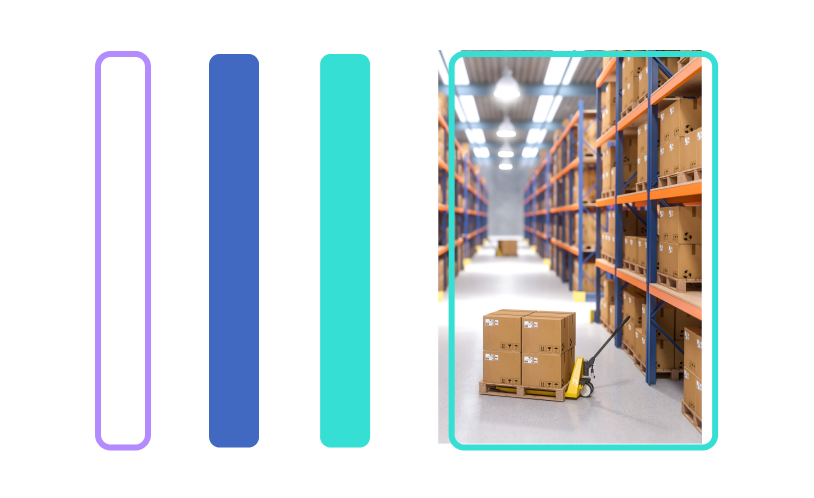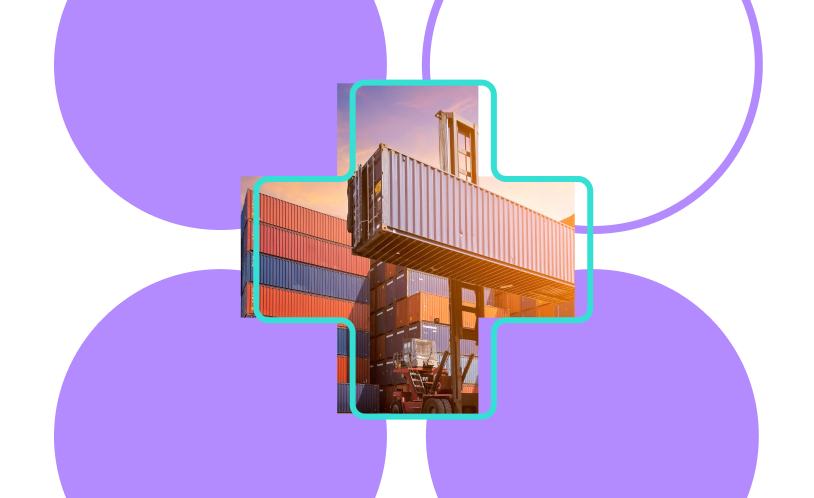How to send products to Amazon FBA
We know what you’re thinking: “Oh, great… Another FBA guide.”
But this one is different.
This is the definitive, no-BS resource for getting your FBA products into any Amazon fulfillment center in North America. We’ve foregone the fluff and created a resource designed to answer one very basic question:
The best way to ship my goods to Amazon FBA
It’s a deceptively simple topic, usually overlooked by those expensive courses and “ultimate” guides that promise to teach “everything you need to know.”
Considering that freight is one of the most substantial supplemental costs for your products, you simply can’t afford to ignore it if you want to guard your profit margins.
So here it is, your missing link: The Complete Amazon FBA Shipment Strategy Guide.
Looking for live quotes from vetted providers?
How to Add a Product on Amazon Seller Central
Your FBA shipment begins with the creation of a new product on Amazon Seller Central.
You will be prompted to begin with a broad category search and then specify the details.
Be specific to ensure that Amazon knows exactly what your product is and that people can find it in the marketplace.

Once you determine how to classify your product, enter what Amazon calls Vital Info. This includes your product ID, name, brand name, and manufacturer.
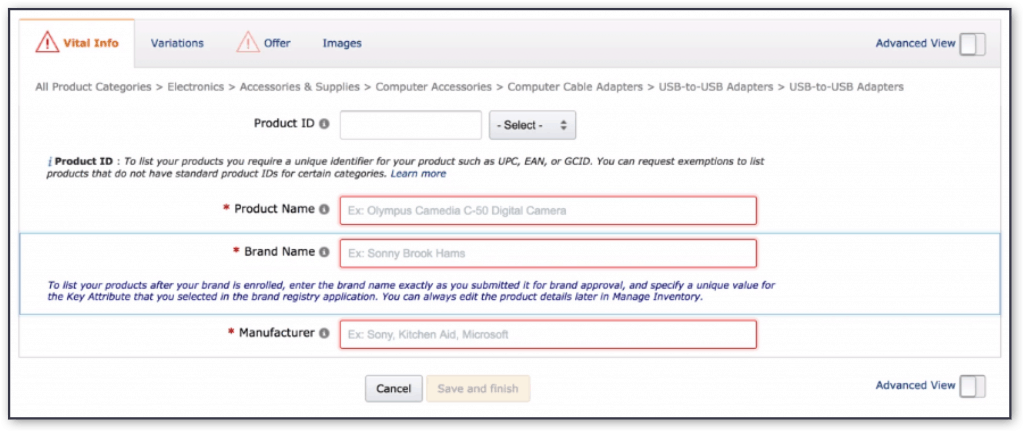
Next, click Offer to set your price. This is also where you can choose your Fulfillment Channel – FBA or FBM.
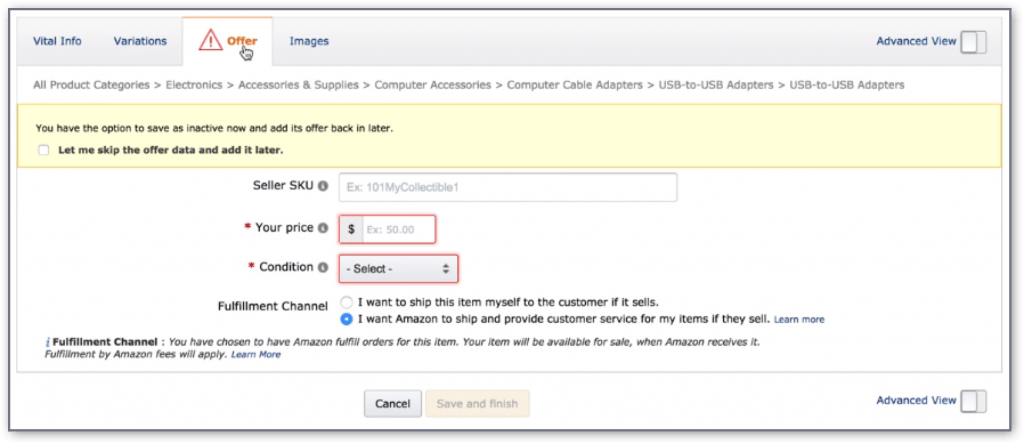
After saving your new product, it can take up to 30 minutes for your listing to be created. It usually takes under two minutes, however.

Once your listing is generated, head to the “Manage Inventory” page.
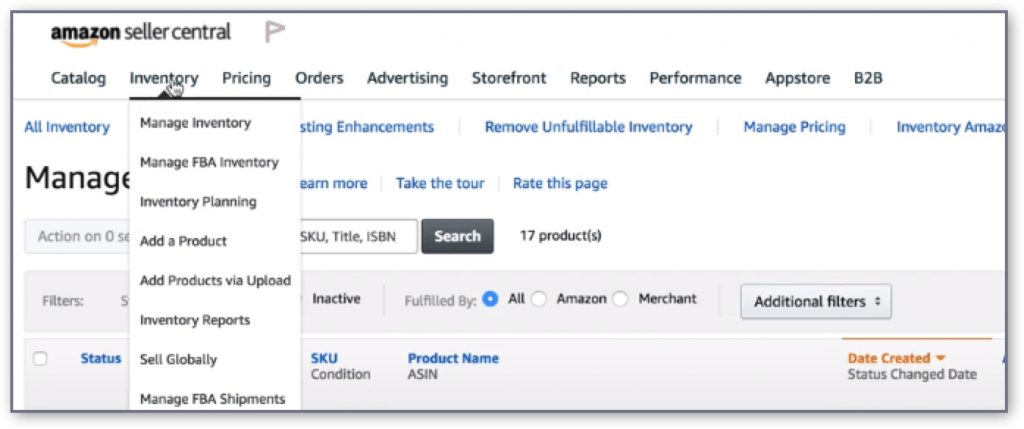
On the Manage Inventory page, find the item you just created and click Edit.
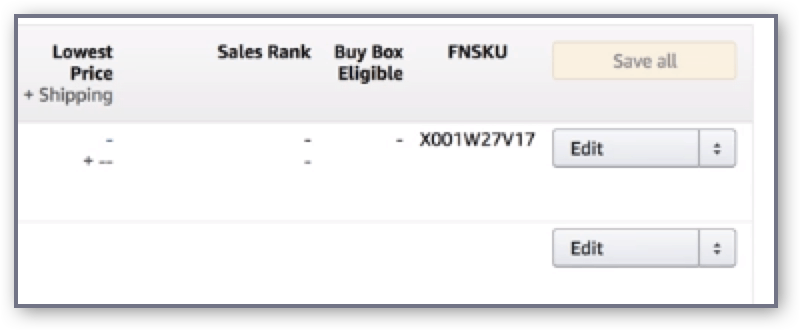
On the following page, you can add images, a product description, and other details about your goods. This is also where you can add your product’s weight, shipping weight, and other crucial shipping details.
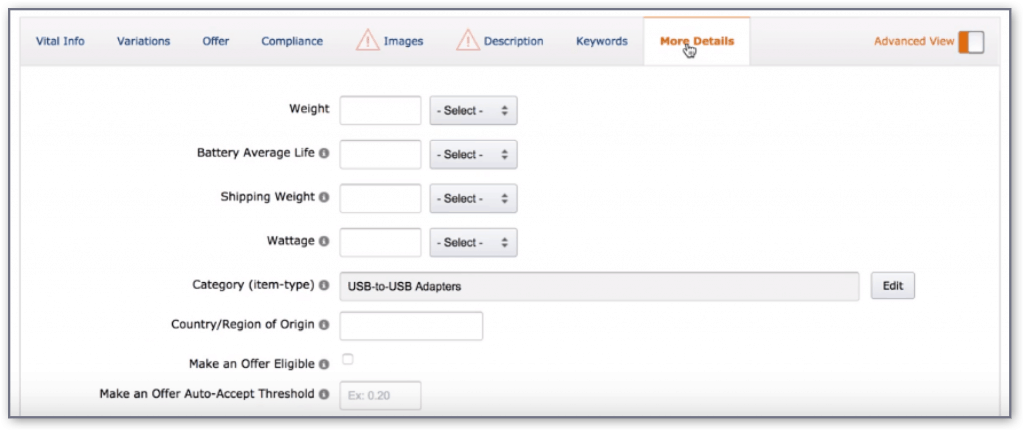
After completing these details, set up your shipment by clicking Send/replenish inventory.
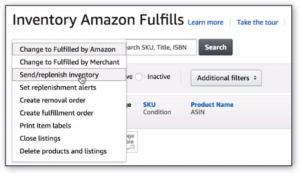
There, you will be required to specify how your products are packed, in addition to the number of units you’re sending.

Be careful to accurately differentiate between units per case and the number of cases. A unit is defined as a single product while a case is comprised of multiple units.
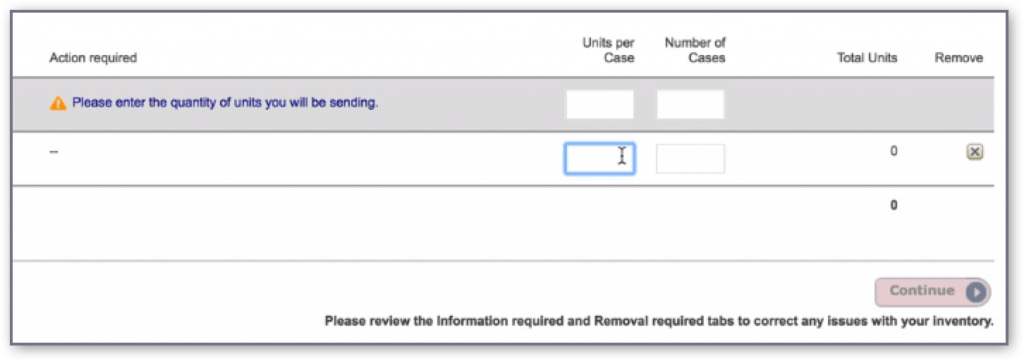
When it comes to determining who will prep your goods, we highly recommend that you leave that to your supplier (Merchant on the drop-down list), as having Amazon do it can be costly. It’s a whole lot more costly if you don’t prepare your goods correctly; make sure you either have your supplier handle this or pay a third-party provider.
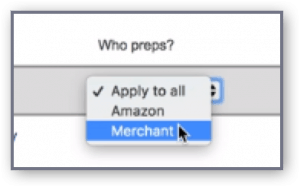
Download the labels by clicking Print labels for this page.
The downloaded labels come in a PDF format which can be sent to the supplier to print and apply or copied (in high resolution) and inserted into product packaging artwork or another tailored label you may use. In this case, make sure the label is barcode readable.

Finally, create and approve the shipment so that Amazon can know to expect your goods. You may alternatively add it to an existing shipment. Just make sure to give your shipments a name that is easy to recognize.

Once you approve a shipment plan, you are required to follow through. Failure to do so may result in suspension of your rights to deliver goods to Amazon and even suspension of your Amazon selling rights.
Amazon FBA Shipping From China to USA
Your shipping destination can have major implications on your freight cost and transit time, especially during the period of coronavirus.
You can optimize both by shipping to the FBA Fulfillment Center closest to your supplier (port of destination). For many shippers with suppliers based in China and shipping to the USA, the closest FBA location would be somewhere in California.
While Amazon doesn’t let you choose which warehouse to ship to, your ‘Ship From’ address can affect your warehouse assignment.
To increase the likelihood of optimal placement, specify that your goods are coming from a warehouse close to the FBA facility you desire instead of your supplier’s address.
As an example, if your inventory is coming from China and the closest delivery location is in Moreno Valley, California, coordinate the delivery of your goods to a forwarder’s warehouse in Los Angeles.
Still following? You may be wondering how you’re supposed to know your forwarder’s address before selecting one. Instead of using your forwarder’s address, simply input the address of the port (eg, LAX or Long Beach).
It’s important to note that this is a hack. It doesn’t always work and Amazon constantly changes its algorithms and the way it selects a specific FBA warehouse. Until then, it’s worth a shot!
Shipping to Amazon FBA
Once your freight shipment is prepared on Seller Central, you can get it ready for shipment.
No matter what your level of experience is with international freight, it’s really easy to make costly errors at this stage.
The three most important considerations when shipping your goods are:
- Shipping Individual Pallets vs. Full Containers
- Packaging and Labeling Your Products
- Finding an Amazon-Friendly Freight Forwarder
Shipping LCL vs. Full Containers
If you’re shipping less than container loads (LCL), it may be worthwhile to consider sending a full container load (FCL).
This is because every shipment has a tipping point where sending less than a container load (LCL) can become more expensive than FCL and scaling up actually lowers your per-unit cost.
You can determine if your shipment meets that tipping point by the number of cartons you want to send. If it’s enough to fill around 50-65% of a 20-foot shipping container (12-15 cartons), you may end up paying the same price as you would for a full container… or more!
Additionally, a 40-foot container usually costs just 20-25% more than a 20-foot container and offers double the volume.
There are other downsides to LCL, too.
When shipping by LCL to Amazon, your cartons are mixed with those of other LCL shippers. That means the container you’re sharing is prone to be opened multiple times by shipping carriers and customs officials, creating a greater risk that your goods will be damaged or delayed. It also adds to the shipping time.
Of course, if your goods don’t sell, you may end up losing that money in other ways such as warehousing and storage fees, not to mention the cost of goods.
You can use this FBA Amazon shipping calculator to get an estimate of what your best course of action might be:
Packaging and Labeling Your FBA Products
Generally speaking, the optimal product to sell online is one that is small and light — easy to ship, even easier to store.
While finding that ideal product is not always possible, there are some steps you can take to ensure that your large or heavy products don’t get hammered with high shipping charges and warehouse fees.
The first step is to recognize the difference between your product dimensions and packaging dimensions. It may seem obvious, but failing to account for the inches added by packaging is not uncommon.
These are the different dimensional categories on Amazon:
| Maximum weights and dimensions for packaged items | |||||
| Product size tier | Weight | Longest side | Median side | Shortest side | Length + Girth |
| Small standard-size | 12 oz. | 15″ | 12″ | 0.75″ | n/a |
| Large standard-size | 20 lb. | 18″ | 14″ | 8″ | n/a |
| Small oversize | 70 lb. | 60″ | 30″ | n/a | 130″ |
| Medium oversize | 150 lb. | 108″ | n/a | n/a | 130″ |
| Large oversize | 150 lb. | 108″ | n/a | n/a | 165″ |
| Special oversize* | Over 150 lb. | Over 108″ | n/a | n/a | Over 165″ |
The second step is to avoid OVERSIZE products whenever possible.
Oversize goods are not only more expensive to ship, but they can also cost a fortune to warehouse.
If your package dimensions have any measurements that border a higher product size tier, you will be charged for even the slightest bulge, bump, or packing tape overhang. Amazon is very precise with measurement. Every inch matters.
A customer shipping on Freightos created a product that comes packaged in a small duffel bag. Despite the product being small enough to meet Amazon’s standard-size tier, the bag bulged out on the sides, causing Amazon to classify it as oversize.
After lots of consideration about how he could repackage his goods in the bag or even change the design of the product completely, the solution finally presented itself: put the bag in a box.
The rigid sides ensured that his goods would remain within their Amazon-regulated confines, proving that sometimes it’s worth thinking inside the box.
Thinking you can game the system? You can’t. Amazon’s strict procedures and automated measuring equipment prevent (and penalize) even the ‘cleverest’ of tricks.
FBA warehouses are equally strict with labeling.
All products sent to Amazon must include a UPC (or equivalent) or specific labeling for FBA (known as an FNSKU). Only one machine readable barcode can appear on the actual product.
In most cases, it is better for FBA to use the Amazon FNSKU barcode (this avoids commingling of products with identical UPCs, while FNSKU is unique to each seller).
If your product has a UPC and an FNSKU on the packaging – the UPC must be covered up (either by the FNSKU label or a white label).
While it is up to you to purchase a valid UPC code for your product, we recommend assigning the task of labeling your goods to your manufacturer or freight forwarder.
Many (but not all) good forwarders know the proper protocol for shipping goods to Amazon and can provide advice when any questions arise.
How To Find an Amazon FBA Freight Forwarder
A freight forwarder is a service provider that arranges your shipments.
A good freight forwarder is well-versed in the shipping process and has the connections necessary to book space for your goods with reliable air and ocean carriers, track the movement of your goods, coordinate the many required documents required, and more.
In order to comply with Amazon FBA’s unique delivery requirements, you’ll also want a forwarder that has experience coordinating the delivery of goods to Amazon warehouses.
We highly recommend getting to know your forwarder through research and reading online reviews. Important evaluation criterion include responsiveness, pricing, and flexibility.
Comparing freight companies can be grueling.
Of course, you can save a lot of time by using Freightos to compare instant freight quotes from 75+ forwarders and carriers, real customer reviews, and expert support.
It’s also important that you educate yourself about some specifics, such as the fees and charges associated with using a forwarder, the contractual agreement you will make (aka Incoterms), the key documents you will be required to provide, and any customs duties you’ll be responsible to pay.
Last-Mile Amazon Logistics
The final step in your FBA freight journey is getting your goods to Amazon’s warehouse. This step is known as last-mile delivery and you can either opt to ship less-than-truckload (LTL) or small parcel delivery (SPD).
LTL vs. SPD

As a general rule, if you are shipping over two pallets, you should defer to your freight forwarder who will know all of the requirements that go with LTL, including:
- Using acceptable pallets
- Adhering to pallet label requirements
- Providing the bill of lading (BOL)
- Scheduling a delivery
If you are shipping fewer than two pallets, you may opt for SPD, which you can coordinate directly on Amazon.
You should always shop around and consider all of your last-mile options, but, for many, the decision comes down to price.
Amazon Inventory Placement Service
Amazon’s inventory placement service (IPS) enables you to send all of your goods to a single fulfillment center without the hassle of worrying about shipping to multiple destinations.
This may seem like a good option at first glance, but opting into this service reduces your ability to choose which FBA center you ship to. That means you may be forced to ship your goods from China to, say, Ohio, massively increasing your costs.
Furthermore, Amazon charges you per unit if you select the service.
Still, there are specific situations in which this could be beneficial to you. You can read more about it here and enable it under Inbound Settings in Seller Central.
Warehousing and Storage
If there’s one thing people underestimate about selling on Amazon, it’s storage costs.
Many make the mistake of believing that Amazon’s huge fulfillment centers have ample room just waiting to be occupied by their goods at little-to-no cost. This is not so.
In fact, Amazon’s warehouse fees end up being burdensome and costly for sellers.
FBA Fees
Amazon’s fees change based on internal pricing considerations and seasonal factors. This is the current fee structure:
| Month | Standard-size | Oversize |
| January – September | $0.69 per cubic foot | $0.48 per cubic foot |
| October – December | $2.40 per cubic foot | $1.20 per cubic foot |
Amazon also charges long-term storage fees for any stock that is stored for longer than 180 days:
| Inventory cleanup date | Items in fulfillment centers 181 to 365 days | Items in fulfillment centers more than 365 days |
| 15th of every month | $3.45 per cubic foot | $6.90 per cubic foot |
In other words, if your item isn’t selling and, as such, is just taking up space, Amazon wants it out and will charge you handsomely for its storage.
These rates change often, frequently taking sellers by surprise. If your goods are already in storage at Amazon’s warehouse, there isn’t much you can do. For planning future inventory, there is another route that many FBA sellers take…
Third-Party Warehouses
Third-party warehouses provide an attractive storage solution for two reasons:
- Storage rates are less fickle in third-party warehouses, fluctuating less often.
- They provide a local ship-from address that you can use when creating your shipment on Amazon.
You can use a third-party warehouse to feed your goods to Amazon’s FBA warehouses on an as-needed basis. This provides greater control over your inventory and some added insurance if your item doesn’t sell as expected.
Of course, if you’re sending a limited number of units, this “just in time” approach probably doesn’t apply. The trick, as with most things FBA, is to understand when to employ these resources.
Is Selling with Amazon FBA Worth It?
With all of these associated fees and logistics, you may be asking yourself if it is worth selling on Amazon. In short, yes.
Why Sell on FBA?
Amazon FBA is a gateway to success like no other.
Selling online used to require building and maintaining a website, devising a marketing campaign, and fulfilling orders. Amazon FBA businesses get all of that instantly with a storefront, exposure to millions of potential buyers, and hands-off order fulfillment.
It’s no wonder that third-party sellers now account for over 50% of Amazon’s yearly sales. And that number is growing.
So the question isn’t really ‘why sell on FBA’ as much as ‘why are you still waiting to do so?’
FBA vs. FBM
In addition to FBA, Amazon offers a service called Fulfillment by Merchant (FBM).
True to its name, FBM enables sellers to use Amazon’s marketplace, but fulfill orders on their end. There are a couple of reasons why we recommend against using FBM:
- No Prime. There are 90 million Amazon Prime users and they account for 90% of purchases on Amazon. While FBA supports Prime shipping, FBM does not. This mere fact is a nonstarter for many customers.
- Difficult Buy Box. It is easier to get FBA products into the Buy Box. This isn’t so relevant for private label products, but if you’re selling goods in competition with others, it’s essential.
Sellers who went from FBM to FBA have tripled their sales, on average.
FBM is the preferred (and only) option when you ship HAZMAT goods.
How To Set Your Price and Deal with Amazon Price Wars
Before setting your price it’s important to get a good idea of the market for your product. Once you see how much people are willing to spend on a similar product, you can calculate the landed cost of your goods to see if you can match or beat them.
You should also include a lot of wiggle room since price wars are very common on Amazon.
A price war occurs when your competitor undercuts you – sometimes even by pennies – in an effort to drive you away from selling your product. As a seller, you have several options for fighting in a price war:
- Actively fight. Change your price as required if you can do so while still remaining profitable. This tactic is not recommended.
- Play the waiting game. Your competitor doesn’t have unlimited stock and price wars often become simple waiting games — especially if competing products are priced so unreasonably low that your competitor’s profits are slim or nonexistent.
- Go high. As counterintuitive as it sounds, pricing your item 20% higher than the lowest priced seller is another tactic that people use. Although you won’t see many sales, you will still see some thanks to the rotation of the Buy Box.
How To Protect Your IP for FBA Shipping
If your product is intellectual property (IP) or is a unique representation of something already patented, sign agreements with your suppliers to ensure they won’t sell them to other clients.
To do this, you will need to prepare and have the supplier sign an NNN agreement (non-disclosure, non-use, non-circumvention) which is available both in English and Chinese and falls under Chinese legal jurisdiction.
Although contracts like these tend to have high minimum order quantities and long-term commitments, if your product sells well, it’s a no-brainer.
The fewer people competing with you on a product, the greater your potential for success is and the less likely you are to get into a pricing war.
Conclusion
Selling on and shipping to Amazon FBA may seem like a daunting task, but with dedication and practice, it will become like second nature. All it takes are some trusted partners, the right tools, and a desire to stay informed and continue to grow.
